Critical Analysis: Real-World Outcomes, Critical Thinking, and Gender
VerifiedAdded on 2022/10/11
|8
|2023
|20
Report
AI Summary
This report provides a critical analysis of the article "Real-World Outcomes and Critical Thinking: Differential Analysis by Academic Major and Gender" by Franco & Almeida (2015). The analysis examines the background, objectives, methodology, and findings of the research, which investigates the relationship between critical thinking skills, as measured by the Halpern Critical Thinking Assessment (HCTA), and real-world outcomes, considering the influence of academic major (STEM vs. Humanities) and gender. The study involved 259 undergraduate students and found no statistically significant differences in real-world outcomes based on academic major or gender. The report critically evaluates the strengths and weaknesses of the article, particularly concerning the limitations of critical thinking and its potential for both positive and negative outcomes. The report concludes by summarizing the key findings and contributions of the article, highlighting the importance of understanding the complex interplay between cognitive abilities, decision-making, and real-life experiences. The report also discusses the implications of these findings for future research and practice, and suggests the need for a more nuanced understanding of the factors that influence critical thinking and its impact on human behavior.
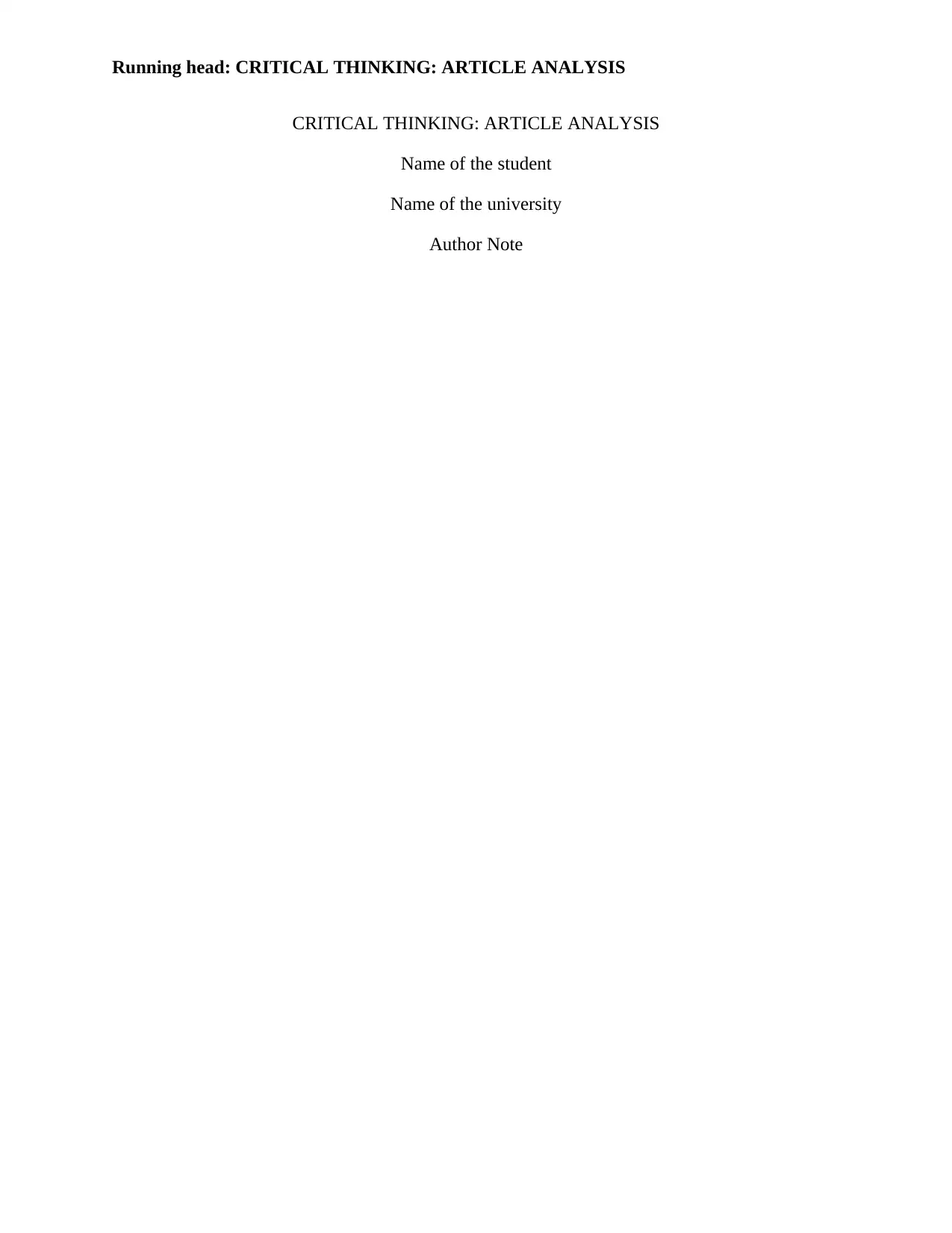
Running head: CRITICAL THINKING: ARTICLE ANALYSIS
CRITICAL THINKING: ARTICLE ANALYSIS
Name of the student
Name of the university
Author Note
CRITICAL THINKING: ARTICLE ANALYSIS
Name of the student
Name of the university
Author Note
Paraphrase This Document
Need a fresh take? Get an instant paraphrase of this document with our AI Paraphraser
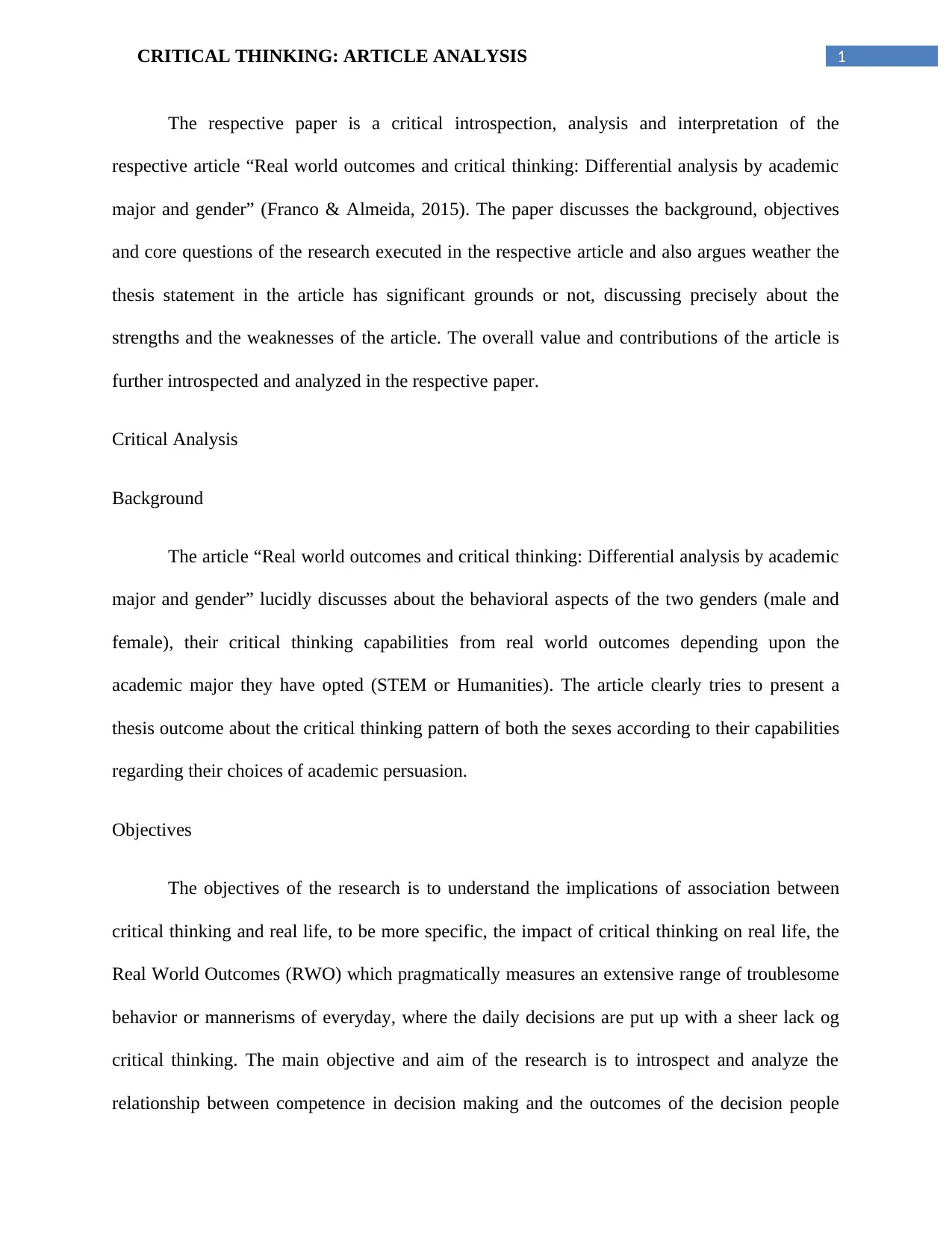
1CRITICAL THINKING: ARTICLE ANALYSIS
The respective paper is a critical introspection, analysis and interpretation of the
respective article “Real world outcomes and critical thinking: Differential analysis by academic
major and gender” (Franco & Almeida, 2015). The paper discusses the background, objectives
and core questions of the research executed in the respective article and also argues weather the
thesis statement in the article has significant grounds or not, discussing precisely about the
strengths and the weaknesses of the article. The overall value and contributions of the article is
further introspected and analyzed in the respective paper.
Critical Analysis
Background
The article “Real world outcomes and critical thinking: Differential analysis by academic
major and gender” lucidly discusses about the behavioral aspects of the two genders (male and
female), their critical thinking capabilities from real world outcomes depending upon the
academic major they have opted (STEM or Humanities). The article clearly tries to present a
thesis outcome about the critical thinking pattern of both the sexes according to their capabilities
regarding their choices of academic persuasion.
Objectives
The objectives of the research is to understand the implications of association between
critical thinking and real life, to be more specific, the impact of critical thinking on real life, the
Real World Outcomes (RWO) which pragmatically measures an extensive range of troublesome
behavior or mannerisms of everyday, where the daily decisions are put up with a sheer lack og
critical thinking. The main objective and aim of the research is to introspect and analyze the
relationship between competence in decision making and the outcomes of the decision people
The respective paper is a critical introspection, analysis and interpretation of the
respective article “Real world outcomes and critical thinking: Differential analysis by academic
major and gender” (Franco & Almeida, 2015). The paper discusses the background, objectives
and core questions of the research executed in the respective article and also argues weather the
thesis statement in the article has significant grounds or not, discussing precisely about the
strengths and the weaknesses of the article. The overall value and contributions of the article is
further introspected and analyzed in the respective paper.
Critical Analysis
Background
The article “Real world outcomes and critical thinking: Differential analysis by academic
major and gender” lucidly discusses about the behavioral aspects of the two genders (male and
female), their critical thinking capabilities from real world outcomes depending upon the
academic major they have opted (STEM or Humanities). The article clearly tries to present a
thesis outcome about the critical thinking pattern of both the sexes according to their capabilities
regarding their choices of academic persuasion.
Objectives
The objectives of the research is to understand the implications of association between
critical thinking and real life, to be more specific, the impact of critical thinking on real life, the
Real World Outcomes (RWO) which pragmatically measures an extensive range of troublesome
behavior or mannerisms of everyday, where the daily decisions are put up with a sheer lack og
critical thinking. The main objective and aim of the research is to introspect and analyze the
relationship between competence in decision making and the outcomes of the decision people
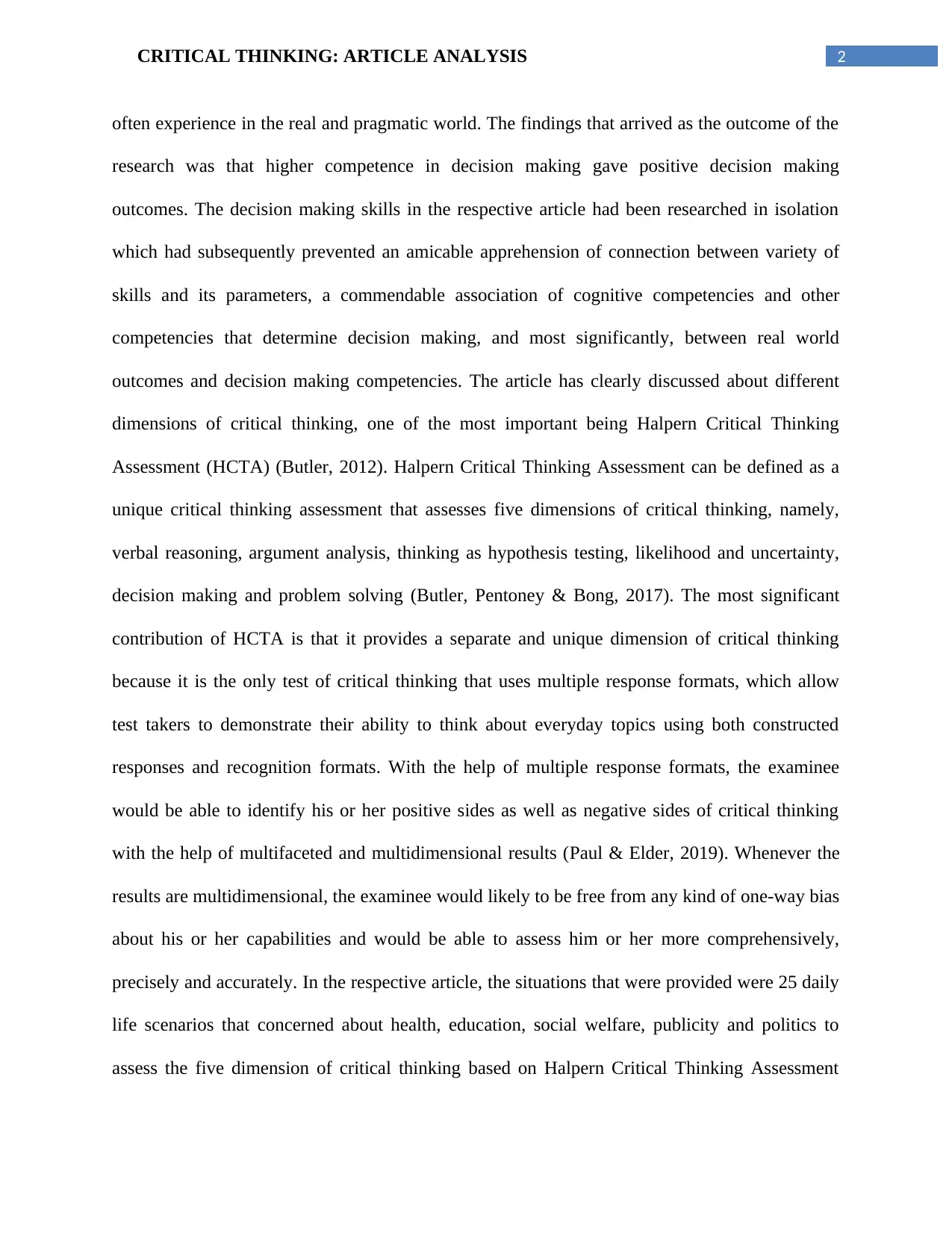
2CRITICAL THINKING: ARTICLE ANALYSIS
often experience in the real and pragmatic world. The findings that arrived as the outcome of the
research was that higher competence in decision making gave positive decision making
outcomes. The decision making skills in the respective article had been researched in isolation
which had subsequently prevented an amicable apprehension of connection between variety of
skills and its parameters, a commendable association of cognitive competencies and other
competencies that determine decision making, and most significantly, between real world
outcomes and decision making competencies. The article has clearly discussed about different
dimensions of critical thinking, one of the most important being Halpern Critical Thinking
Assessment (HCTA) (Butler, 2012). Halpern Critical Thinking Assessment can be defined as a
unique critical thinking assessment that assesses five dimensions of critical thinking, namely,
verbal reasoning, argument analysis, thinking as hypothesis testing, likelihood and uncertainty,
decision making and problem solving (Butler, Pentoney & Bong, 2017). The most significant
contribution of HCTA is that it provides a separate and unique dimension of critical thinking
because it is the only test of critical thinking that uses multiple response formats, which allow
test takers to demonstrate their ability to think about everyday topics using both constructed
responses and recognition formats. With the help of multiple response formats, the examinee
would be able to identify his or her positive sides as well as negative sides of critical thinking
with the help of multifaceted and multidimensional results (Paul & Elder, 2019). Whenever the
results are multidimensional, the examinee would likely to be free from any kind of one-way bias
about his or her capabilities and would be able to assess him or her more comprehensively,
precisely and accurately. In the respective article, the situations that were provided were 25 daily
life scenarios that concerned about health, education, social welfare, publicity and politics to
assess the five dimension of critical thinking based on Halpern Critical Thinking Assessment
often experience in the real and pragmatic world. The findings that arrived as the outcome of the
research was that higher competence in decision making gave positive decision making
outcomes. The decision making skills in the respective article had been researched in isolation
which had subsequently prevented an amicable apprehension of connection between variety of
skills and its parameters, a commendable association of cognitive competencies and other
competencies that determine decision making, and most significantly, between real world
outcomes and decision making competencies. The article has clearly discussed about different
dimensions of critical thinking, one of the most important being Halpern Critical Thinking
Assessment (HCTA) (Butler, 2012). Halpern Critical Thinking Assessment can be defined as a
unique critical thinking assessment that assesses five dimensions of critical thinking, namely,
verbal reasoning, argument analysis, thinking as hypothesis testing, likelihood and uncertainty,
decision making and problem solving (Butler, Pentoney & Bong, 2017). The most significant
contribution of HCTA is that it provides a separate and unique dimension of critical thinking
because it is the only test of critical thinking that uses multiple response formats, which allow
test takers to demonstrate their ability to think about everyday topics using both constructed
responses and recognition formats. With the help of multiple response formats, the examinee
would be able to identify his or her positive sides as well as negative sides of critical thinking
with the help of multifaceted and multidimensional results (Paul & Elder, 2019). Whenever the
results are multidimensional, the examinee would likely to be free from any kind of one-way bias
about his or her capabilities and would be able to assess him or her more comprehensively,
precisely and accurately. In the respective article, the situations that were provided were 25 daily
life scenarios that concerned about health, education, social welfare, publicity and politics to
assess the five dimension of critical thinking based on Halpern Critical Thinking Assessment
⊘ This is a preview!⊘
Do you want full access?
Subscribe today to unlock all pages.

Trusted by 1+ million students worldwide
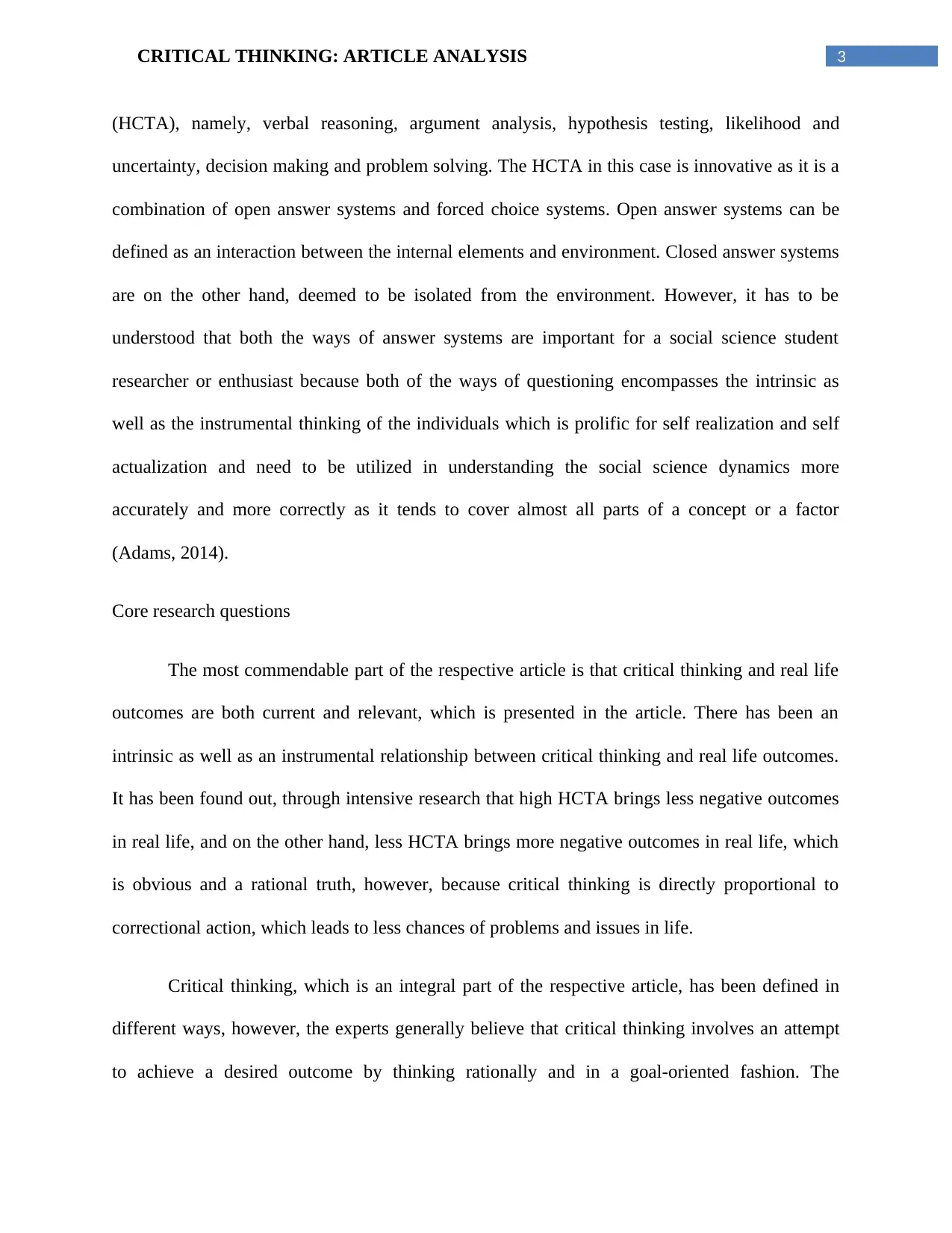
3CRITICAL THINKING: ARTICLE ANALYSIS
(HCTA), namely, verbal reasoning, argument analysis, hypothesis testing, likelihood and
uncertainty, decision making and problem solving. The HCTA in this case is innovative as it is a
combination of open answer systems and forced choice systems. Open answer systems can be
defined as an interaction between the internal elements and environment. Closed answer systems
are on the other hand, deemed to be isolated from the environment. However, it has to be
understood that both the ways of answer systems are important for a social science student
researcher or enthusiast because both of the ways of questioning encompasses the intrinsic as
well as the instrumental thinking of the individuals which is prolific for self realization and self
actualization and need to be utilized in understanding the social science dynamics more
accurately and more correctly as it tends to cover almost all parts of a concept or a factor
(Adams, 2014).
Core research questions
The most commendable part of the respective article is that critical thinking and real life
outcomes are both current and relevant, which is presented in the article. There has been an
intrinsic as well as an instrumental relationship between critical thinking and real life outcomes.
It has been found out, through intensive research that high HCTA brings less negative outcomes
in real life, and on the other hand, less HCTA brings more negative outcomes in real life, which
is obvious and a rational truth, however, because critical thinking is directly proportional to
correctional action, which leads to less chances of problems and issues in life.
Critical thinking, which is an integral part of the respective article, has been defined in
different ways, however, the experts generally believe that critical thinking involves an attempt
to achieve a desired outcome by thinking rationally and in a goal-oriented fashion. The
(HCTA), namely, verbal reasoning, argument analysis, hypothesis testing, likelihood and
uncertainty, decision making and problem solving. The HCTA in this case is innovative as it is a
combination of open answer systems and forced choice systems. Open answer systems can be
defined as an interaction between the internal elements and environment. Closed answer systems
are on the other hand, deemed to be isolated from the environment. However, it has to be
understood that both the ways of answer systems are important for a social science student
researcher or enthusiast because both of the ways of questioning encompasses the intrinsic as
well as the instrumental thinking of the individuals which is prolific for self realization and self
actualization and need to be utilized in understanding the social science dynamics more
accurately and more correctly as it tends to cover almost all parts of a concept or a factor
(Adams, 2014).
Core research questions
The most commendable part of the respective article is that critical thinking and real life
outcomes are both current and relevant, which is presented in the article. There has been an
intrinsic as well as an instrumental relationship between critical thinking and real life outcomes.
It has been found out, through intensive research that high HCTA brings less negative outcomes
in real life, and on the other hand, less HCTA brings more negative outcomes in real life, which
is obvious and a rational truth, however, because critical thinking is directly proportional to
correctional action, which leads to less chances of problems and issues in life.
Critical thinking, which is an integral part of the respective article, has been defined in
different ways, however, the experts generally believe that critical thinking involves an attempt
to achieve a desired outcome by thinking rationally and in a goal-oriented fashion. The
Paraphrase This Document
Need a fresh take? Get an instant paraphrase of this document with our AI Paraphraser
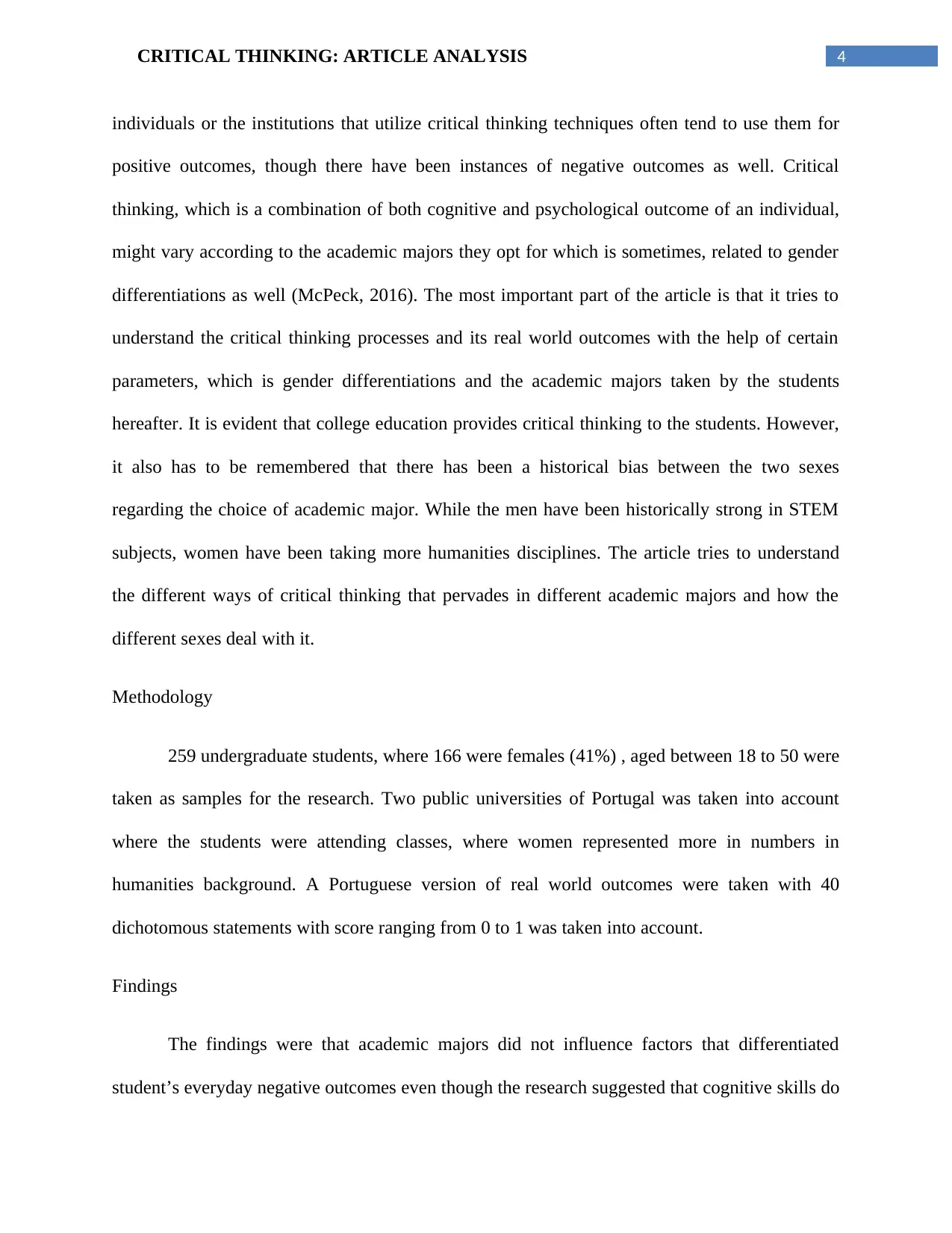
4CRITICAL THINKING: ARTICLE ANALYSIS
individuals or the institutions that utilize critical thinking techniques often tend to use them for
positive outcomes, though there have been instances of negative outcomes as well. Critical
thinking, which is a combination of both cognitive and psychological outcome of an individual,
might vary according to the academic majors they opt for which is sometimes, related to gender
differentiations as well (McPeck, 2016). The most important part of the article is that it tries to
understand the critical thinking processes and its real world outcomes with the help of certain
parameters, which is gender differentiations and the academic majors taken by the students
hereafter. It is evident that college education provides critical thinking to the students. However,
it also has to be remembered that there has been a historical bias between the two sexes
regarding the choice of academic major. While the men have been historically strong in STEM
subjects, women have been taking more humanities disciplines. The article tries to understand
the different ways of critical thinking that pervades in different academic majors and how the
different sexes deal with it.
Methodology
259 undergraduate students, where 166 were females (41%) , aged between 18 to 50 were
taken as samples for the research. Two public universities of Portugal was taken into account
where the students were attending classes, where women represented more in numbers in
humanities background. A Portuguese version of real world outcomes were taken with 40
dichotomous statements with score ranging from 0 to 1 was taken into account.
Findings
The findings were that academic majors did not influence factors that differentiated
student’s everyday negative outcomes even though the research suggested that cognitive skills do
individuals or the institutions that utilize critical thinking techniques often tend to use them for
positive outcomes, though there have been instances of negative outcomes as well. Critical
thinking, which is a combination of both cognitive and psychological outcome of an individual,
might vary according to the academic majors they opt for which is sometimes, related to gender
differentiations as well (McPeck, 2016). The most important part of the article is that it tries to
understand the critical thinking processes and its real world outcomes with the help of certain
parameters, which is gender differentiations and the academic majors taken by the students
hereafter. It is evident that college education provides critical thinking to the students. However,
it also has to be remembered that there has been a historical bias between the two sexes
regarding the choice of academic major. While the men have been historically strong in STEM
subjects, women have been taking more humanities disciplines. The article tries to understand
the different ways of critical thinking that pervades in different academic majors and how the
different sexes deal with it.
Methodology
259 undergraduate students, where 166 were females (41%) , aged between 18 to 50 were
taken as samples for the research. Two public universities of Portugal was taken into account
where the students were attending classes, where women represented more in numbers in
humanities background. A Portuguese version of real world outcomes were taken with 40
dichotomous statements with score ranging from 0 to 1 was taken into account.
Findings
The findings were that academic majors did not influence factors that differentiated
student’s everyday negative outcomes even though the research suggested that cognitive skills do
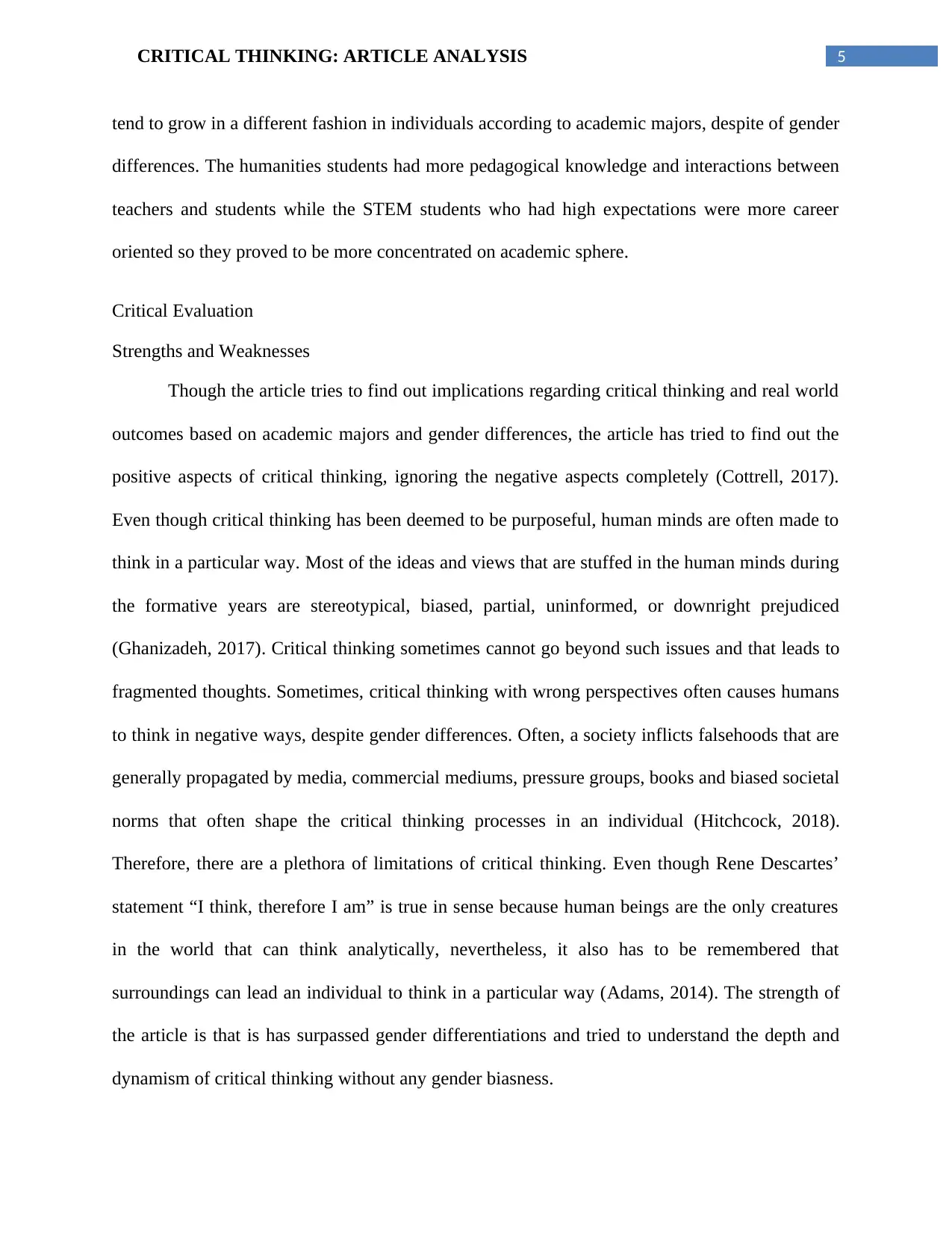
5CRITICAL THINKING: ARTICLE ANALYSIS
tend to grow in a different fashion in individuals according to academic majors, despite of gender
differences. The humanities students had more pedagogical knowledge and interactions between
teachers and students while the STEM students who had high expectations were more career
oriented so they proved to be more concentrated on academic sphere.
Critical Evaluation
Strengths and Weaknesses
Though the article tries to find out implications regarding critical thinking and real world
outcomes based on academic majors and gender differences, the article has tried to find out the
positive aspects of critical thinking, ignoring the negative aspects completely (Cottrell, 2017).
Even though critical thinking has been deemed to be purposeful, human minds are often made to
think in a particular way. Most of the ideas and views that are stuffed in the human minds during
the formative years are stereotypical, biased, partial, uninformed, or downright prejudiced
(Ghanizadeh, 2017). Critical thinking sometimes cannot go beyond such issues and that leads to
fragmented thoughts. Sometimes, critical thinking with wrong perspectives often causes humans
to think in negative ways, despite gender differences. Often, a society inflicts falsehoods that are
generally propagated by media, commercial mediums, pressure groups, books and biased societal
norms that often shape the critical thinking processes in an individual (Hitchcock, 2018).
Therefore, there are a plethora of limitations of critical thinking. Even though Rene Descartes’
statement “I think, therefore I am” is true in sense because human beings are the only creatures
in the world that can think analytically, nevertheless, it also has to be remembered that
surroundings can lead an individual to think in a particular way (Adams, 2014). The strength of
the article is that is has surpassed gender differentiations and tried to understand the depth and
dynamism of critical thinking without any gender biasness.
tend to grow in a different fashion in individuals according to academic majors, despite of gender
differences. The humanities students had more pedagogical knowledge and interactions between
teachers and students while the STEM students who had high expectations were more career
oriented so they proved to be more concentrated on academic sphere.
Critical Evaluation
Strengths and Weaknesses
Though the article tries to find out implications regarding critical thinking and real world
outcomes based on academic majors and gender differences, the article has tried to find out the
positive aspects of critical thinking, ignoring the negative aspects completely (Cottrell, 2017).
Even though critical thinking has been deemed to be purposeful, human minds are often made to
think in a particular way. Most of the ideas and views that are stuffed in the human minds during
the formative years are stereotypical, biased, partial, uninformed, or downright prejudiced
(Ghanizadeh, 2017). Critical thinking sometimes cannot go beyond such issues and that leads to
fragmented thoughts. Sometimes, critical thinking with wrong perspectives often causes humans
to think in negative ways, despite gender differences. Often, a society inflicts falsehoods that are
generally propagated by media, commercial mediums, pressure groups, books and biased societal
norms that often shape the critical thinking processes in an individual (Hitchcock, 2018).
Therefore, there are a plethora of limitations of critical thinking. Even though Rene Descartes’
statement “I think, therefore I am” is true in sense because human beings are the only creatures
in the world that can think analytically, nevertheless, it also has to be remembered that
surroundings can lead an individual to think in a particular way (Adams, 2014). The strength of
the article is that is has surpassed gender differentiations and tried to understand the depth and
dynamism of critical thinking without any gender biasness.
⊘ This is a preview!⊘
Do you want full access?
Subscribe today to unlock all pages.

Trusted by 1+ million students worldwide
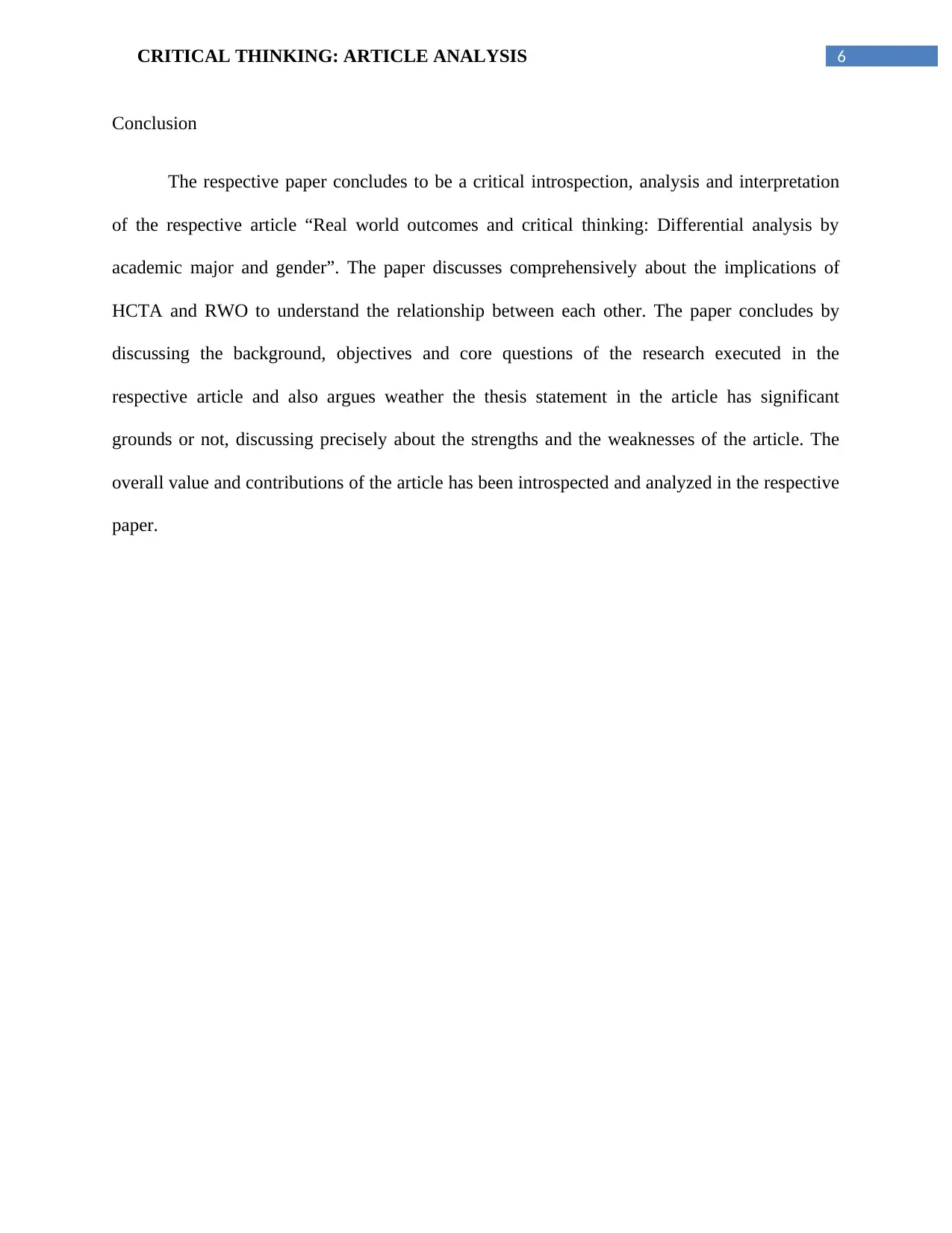
6CRITICAL THINKING: ARTICLE ANALYSIS
Conclusion
The respective paper concludes to be a critical introspection, analysis and interpretation
of the respective article “Real world outcomes and critical thinking: Differential analysis by
academic major and gender”. The paper discusses comprehensively about the implications of
HCTA and RWO to understand the relationship between each other. The paper concludes by
discussing the background, objectives and core questions of the research executed in the
respective article and also argues weather the thesis statement in the article has significant
grounds or not, discussing precisely about the strengths and the weaknesses of the article. The
overall value and contributions of the article has been introspected and analyzed in the respective
paper.
Conclusion
The respective paper concludes to be a critical introspection, analysis and interpretation
of the respective article “Real world outcomes and critical thinking: Differential analysis by
academic major and gender”. The paper discusses comprehensively about the implications of
HCTA and RWO to understand the relationship between each other. The paper concludes by
discussing the background, objectives and core questions of the research executed in the
respective article and also argues weather the thesis statement in the article has significant
grounds or not, discussing precisely about the strengths and the weaknesses of the article. The
overall value and contributions of the article has been introspected and analyzed in the respective
paper.
Paraphrase This Document
Need a fresh take? Get an instant paraphrase of this document with our AI Paraphraser
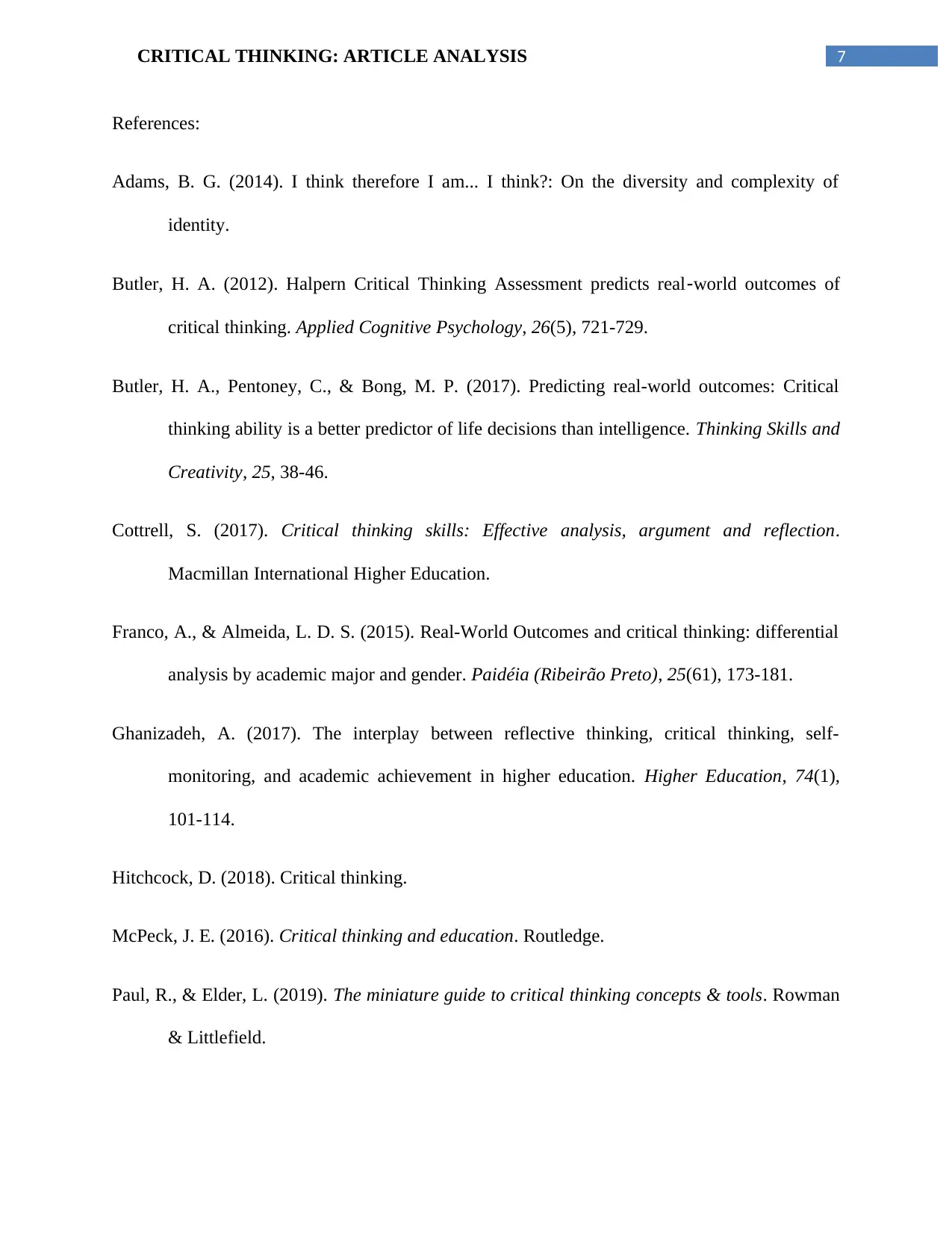
7CRITICAL THINKING: ARTICLE ANALYSIS
References:
Adams, B. G. (2014). I think therefore I am... I think?: On the diversity and complexity of
identity.
Butler, H. A. (2012). Halpern Critical Thinking Assessment predicts real‐world outcomes of
critical thinking. Applied Cognitive Psychology, 26(5), 721-729.
Butler, H. A., Pentoney, C., & Bong, M. P. (2017). Predicting real-world outcomes: Critical
thinking ability is a better predictor of life decisions than intelligence. Thinking Skills and
Creativity, 25, 38-46.
Cottrell, S. (2017). Critical thinking skills: Effective analysis, argument and reflection.
Macmillan International Higher Education.
Franco, A., & Almeida, L. D. S. (2015). Real-World Outcomes and critical thinking: differential
analysis by academic major and gender. Paidéia (Ribeirão Preto), 25(61), 173-181.
Ghanizadeh, A. (2017). The interplay between reflective thinking, critical thinking, self-
monitoring, and academic achievement in higher education. Higher Education, 74(1),
101-114.
Hitchcock, D. (2018). Critical thinking.
McPeck, J. E. (2016). Critical thinking and education. Routledge.
Paul, R., & Elder, L. (2019). The miniature guide to critical thinking concepts & tools. Rowman
& Littlefield.
References:
Adams, B. G. (2014). I think therefore I am... I think?: On the diversity and complexity of
identity.
Butler, H. A. (2012). Halpern Critical Thinking Assessment predicts real‐world outcomes of
critical thinking. Applied Cognitive Psychology, 26(5), 721-729.
Butler, H. A., Pentoney, C., & Bong, M. P. (2017). Predicting real-world outcomes: Critical
thinking ability is a better predictor of life decisions than intelligence. Thinking Skills and
Creativity, 25, 38-46.
Cottrell, S. (2017). Critical thinking skills: Effective analysis, argument and reflection.
Macmillan International Higher Education.
Franco, A., & Almeida, L. D. S. (2015). Real-World Outcomes and critical thinking: differential
analysis by academic major and gender. Paidéia (Ribeirão Preto), 25(61), 173-181.
Ghanizadeh, A. (2017). The interplay between reflective thinking, critical thinking, self-
monitoring, and academic achievement in higher education. Higher Education, 74(1),
101-114.
Hitchcock, D. (2018). Critical thinking.
McPeck, J. E. (2016). Critical thinking and education. Routledge.
Paul, R., & Elder, L. (2019). The miniature guide to critical thinking concepts & tools. Rowman
& Littlefield.
1 out of 8
Related Documents
Your All-in-One AI-Powered Toolkit for Academic Success.
+13062052269
info@desklib.com
Available 24*7 on WhatsApp / Email
![[object Object]](/_next/static/media/star-bottom.7253800d.svg)
Unlock your academic potential
Copyright © 2020–2025 A2Z Services. All Rights Reserved. Developed and managed by ZUCOL.





